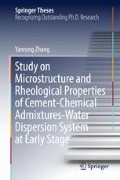Access this chapter
Tax calculation will be finalised at checkout
Purchases are for personal use only
References
Autier C, Azema N, Taulemesse JM et al (2013) Mesostructure evolution of cement pastes with addition of superplasticizers highlighted by dispersion indices. Powder Technol 249(11):282–289
Banfill PFG, Bowen P, Flatt RJ et al (2007) Improved superplasticisers for high performance concrete: the SUPERPLAST project. Abstract CD ROM of the twelfth international congress on the chemistry of cement, Montreal, Canada, 8–13 July
Chanvillard G, Laetitia D (1997) Concrete strength estimation at early ages: modification of the method of equivalent age. ACI Mater J 94(6):220–227
Ferrari L, Kaufmann J, Winnefeld F et al (2010) Interaction of cement model systems with superplasticizers investigated by atomic force microscopy, zeta potential, and adsorption measurements. J Colloid Interface Sci 347(1):15–24
Flatt RJ (2004) Towards a prediction of superplasticized concrete rheology. Mater Struct 37(5):289–300
Flatt RJ, Bowen P (2006) Yodel: a yield stress model for suspensions. J Am Ceram Soc 89(4):1244–1256
Flatt RJ, Bowen P (2007) Yield stress of multimodal powder suspensions: an extension of the YODEL (Yield Stress mODEL). J Am Ceram Soc 90(4):1038–1044
Frankel NA, Acrivos A (1967) On the viscosity of a concentrated suspension of solid spheres. Chem Eng Sci 22(6):847–853
Golaszewski J, Szwabowski J (2004) Influence of superplasticizers on rheological behavior of fresh cement mortars. Cem Concr Res 34(2):235–248
Hansen PF, Pedersen EJ (1977) Maturity computer for controlled curing and hardening of concrete, Nordisk Betong, 41(19):21–25
Hansen FP, Pederson EJ (1985) Curing of concrete structures, Draft DEB-guide to durable concrete structures, Appendix 1, Comite Euro-International du Beton, Lausanne, Switzerland.
Kapur PC, Scales PJ, Boger DV et al (1997) Yield stress of suspensions loaded with size distributed particles. AIChE J 43(5):1171–1179
Kauppi A, Banfill PFG, Bowen P et al (2003) Improved superplasticizers for high performance concrete. In: Proceedings of the 11th international congress on the chemistry of cement, New Delhi, India, 2(LTP-CONF-2003-001), p 8
Kong XM, Zhang YR, Hou SS (2013) Study on the rheological properties of Portland cement pastes with polycarboxylate superplasticizers. Rheol Acta 52(7):707–718
Krieger IM (1972) Rheology of monodisperse latices. Adv Coll Interface Sci 3(2):111–136
Krieger IM, Dougherty TJ (1959) A mechanism for non-Newtonian flow in suspensions of rigid spheres. Trans Soc Rheol (1957–1977) 3(1):137–152
Lin F, Meyer C (2009) Hydration kinetics modeling of Portland cement considering the effects of curing temperature and applied pressure. Cem Concr Res 39(4):255–265
Mills RH (1966) Factors influencing cessation of hydration in water cured cement pastes. Highway research board special report (90), pp 406–424
Morris JF (2009) A review of microstructure in concentrated suspensions and its implications for rheology and bulk flow. Rheol Acta 48(8):909–923
Nawa T (2006) Effect of chemical structure on steric stabilization of polycarboxylate-based superplasticizer. J Adv Concr Technol 4(2):225–232
Pane I, Hansen W (2002) Concrete hydration and mechanical properties under nonisothermal conditions. ACI Mater J 99(6):534–542
Probstein RF, Sengun MZ, Tseng TC (1994) Bimodal model of concentrated suspension viscosity for distributed particle sizes. J Rheol 38(4):811–829
Roncero J, Valls S, Gettu R (2002) Study of the influence of superplasticizers on the hydration of cement paste using nuclear magnetic resonance and X-ray diffraction techniques. Cem Concr Res 32(1):103–108
Sheinn AMM, Ho DWS, Tam CT (2002) Rheological model for self-compacting concrete-paste rheology. In: Proceedings of the 27th conference on our world in concrete and structures, Singapore, pp 28–29
Struble L, Sun GK (1995) Viscosity of Portland cement paste as a function of concentration. Adv Cem Based Mater 2(2):62–69
Wang LJ, Huang FY, Ma XC (2008a) Experimental research on the saturation point of superplasticizers in cement based on fractal dimension. J Wuhan Univ Technol 30(2):28–31 (in Chinese)
Wang LJ, Tan XQ, Cao ML (2008b) Study on flocculated cement based on fractal theory. J Shenyang Jianzhu Univ (Nat Sci) 23(1):82–84 (in Chinese)
Wang DM, Zhang LR, Zhang WL et al (2013) Effects of superplasticizers on multi-level flocculation structure of fresh cement paste. J Build Mater 15(6):755–759 (in Chinese)
Zhang LR, Wang DM, Zhang WL et al (2013) Observation of multi-level flocculation structure of fresh paste using laser scanning confocal microscopy. J Chin Electron Microsc Soc 32(3):231–236 (in Chinese)
Zhou JZQ, Uhlherr PHT, Luo FT (1995) Yield stress and maximum packing fraction of concentrated suspensions. Rheol Acta 34(6):544–561
Author information
Authors and Affiliations
Corresponding author
Rights and permissions
Copyright information
© 2018 Springer Nature Singapore Pte Ltd.
About this chapter
Cite this chapter
Zhang, Y. (2018). Microstructure Model and Rheological Model of Fresh Cement Pastes. In: Study on Microstructure and Rheological Properties of Cement-Chemical Admixtures-Water Dispersion System at Early Stage. Springer Theses. Springer, Singapore. https://doi.org/10.1007/978-981-10-4570-7_6
Download citation
DOI: https://doi.org/10.1007/978-981-10-4570-7_6
Published:
Publisher Name: Springer, Singapore
Print ISBN: 978-981-10-4569-1
Online ISBN: 978-981-10-4570-7
eBook Packages: EngineeringEngineering (R0)

